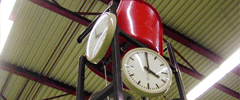Siegerswoude NL 2020
Gino Damen
German summary
Im Wochenende von 7 bis 9 Februar war das zweite Winter Treffen von die Niederländische H0-US Gruppe. Im das Gemeinschaftshaus war eine Aufstellung angedacht wo Kohle von die Mine nach das Meer transportiert werde. Auch war da das erste mal das wir alle Zuge mit Zwei Personen fahren und das wir ein Rulebook nutzten für die Umgang mit die Wagen und Zuge.
From the Summit to the Lakes.
Somewhere along the shores of the Great Lakes a short line is thanking it’s existence on the coal found in the mountains. The line was build by the local coal magnet in the early 1900’s. The mines weren’t big enough to justify the building of a large coal dock. In stead a terminal was build where barges could be loaded with the hoppers loaded with coal.
During the depression the short line got connected with the rest of the rail system. On that spot a small yard was constructed to receive and send the cars for the local industries. Despite the land line the barge is still used to transport hoppers with coal across the lakes to the power plants and forges. Besides coal hoppers the barge is also used to ship the occasional load of perishables.
The layout
The layout is designed with this story in the back of our mind. So at one side we start at the turning loop which also acts as one of the mines in the mountain. Almost adjacent is the biggest mine on the line. Slowly the line descends to the first significant town in the foothills of the mountains. After crossing the planes and the regional centre the line passes the entry to the yard and the rest of the world. The line it self continues to descend to the shores of the lakes where it passes an other small town to cross a small rock outcrop to end at the holding yard for the cars to be loaded and unloaded from the barge.
The meeting
This is the third time we, the US-group living in Friesland, organises this meeting. Each time we try to add something new to make it a bit more realistic. This time around we designed the train schedule to accommodate the usage of a two-man crew, an engineer and a conductor. This proved to be a resounding success. The novice participants could start as engineer and the more experienced participants acted as conductor. So nobody got lost by the tasks they needed to accomplish with their train. An other nice aspect was that a lot of participants liked the interaction (discussion) needed to get the trains running on time and within keeping of the rules. Those rules was also something new we introduced. The rules were about slowing down the handling of the cars and included:
- Always use the 3-step procedure during switching.
- Apply and release the handbrakes on cars at set-outs and pick-ups.
- Secure the back of the train using a flagman.
- Before moving a car and/or moving the train always perform an air test.
Each of these steps and many more the conductor or engineer had to perform was documented, timed and even assisted using an interactive train crew website.
An other nice touch was that we encouraged the engineer to keep in mind that, although flat in reality, the line has quiet a large gradient at the hills and that he needed to think about keeping the speed low and preventing the brakes from overheating. This meant that the many options we have in our engines equipped with modern sound decoders (mostly ESU) could be used to simulate that the engines roared at notch 8 (full throttle) while crawling up hill at snails pace. Going down hill the opposite was done with engines running almost idle and the dynamic brakes fans running like crazy.
We managed to hold 3 operating sessions and had about 40 participants and visitors during the weekend.
Links:
More photos: https://www.flickr.com/photos/23682868@N07/albums/72157712848170022
Train crew: (http://traincrew.conrail1285.com/)
Forum: https://forum.fremo-net.eu/t/second-wintermeeting-siegerswoude/10362







